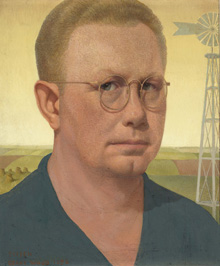
THE SELF-PORTRAIT A Shy Man throughout his life, Wood looks at us here with a keen intelligence. Note the trademark windmill at right. |
This story was originally published in the October 4, 1996, issue of the Boston Phoenix.
Even if the name isn't instantly familiar, the painting will be. You've seen it on billboards, on magazine covers from Mad to Time, in Charles Addams cartoons, on Johnny Carson and Saturday Night Live, and with the heads of first couples superimposed: Jimmy and Rosalynn, Ron and Nancy, Hill and Bill, Dick and Spiro — yes, it's American Gothic, and it must be the most parodied canvas in the history of painting, maybe the most parodied artwork ever. Its creator, a sleepy-looking fellow from rural Iowa, is held up as being to art what Ed Wood is to film. Yet the Worcester Art Museum is trying to pass Grant Wood off as an "American Master." Is this some kind of election-year joke? What gives?
Actually, the WAM has understated its case. The eye-popping exhibition that's opening in Worcester this Sunday, "Grant Wood: An American Master Revealed," reveals its subject to be a grandmaster who's a step ahead of public perception, and hipper than most of his critics. The exhibit is making its third and final stop here, having gone first to the Joslyn Art Museum in Omaha and the Davenport Museum of Art in Wood's native Iowa. Its appearance in Worcester is a major coup, probably the art event of the year.
Not convinced? Take a quick look at Wood's 1932 Daughters of Revolution (not in the show, unfortunately, but you can catch it in the video room). Three ladies can be seen framing a reproduction of Emanuel Leutze's Washington Crossing the Delaware, and a more unrevolutionary-looking lot you couldn't imagine: tight-mouthed, thin-lipped, with dull, vacant eyes and not a hint of intelligence. They're wearing granny dresses, and the one in the middle is holding a Blue Willow teacup in an affected manner, her ring finger conspicuously bare. Behind them Washington looms majestically, heroically; God help us, you think, if these really are the daughters of revolution.
There's a story behind this painting. Five years earlier, in 1927, Wood had been commissioned by the city of Cedar Rapids to create a stained-glass window for the Veterans Memorial Coliseum. Unhappy with the quality of American-made glass, he went to Munich in 1928, where he found his needs met by the Emil Frei Company. The window was finished in 1920, but it was not dedicated till 1955, because the Daughters of the American Revolution contended that a German company should not have been allowed to fabricate a World War I memorial.
Daughters of Revolution is Wood's satiric response. (It can't have been lost on him that Leutze was born in Germany and painted his Washington in Düsseldorf.) And yet — with Grant Wood there's always an "and yet" — the ladies depicted with merciless realism, while behind them Washington and his troops parade in all their mythologized majesty. Insular and narrow-minded, these nevertheless are the daughters of the American Revolution.